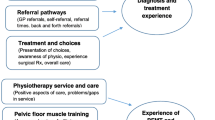Abstract
Introduction and hypothesis
Limited data exist on women’s experience with pelvic organ prolapse (POP) symptoms. We aimed to describe factors that prevent disease understanding among Spanish-speaking and English-speaking women.
Methods
Women with POP were recruited from female urology and urogynecology clinics in Los Angeles, California, and Albuquerque, New Mexico. Eight focus groups were conducted, four in Spanish and four in English. Topics addressed patients’ emotional responses when noticing their prolapse, how they sought support, what verbal and written information was given, and their overall feelings of the process. Additionally, patients were asked about their experience with their treating physician. All interview transcripts were analyzed using grounded theory qualitative methods.
Results
Qualitative analysis yielded two preliminary themes. First, women had misconceptions about what POP is as well as its causes and treatments. Second, there was a great deal of miscommunication between patient and physician which led to decreased understanding about the diagnosis and treatment options. This included the fact that women were often overwhelmed with information which they did not understand. The concept emerged that there is a strong need for better methods to achieve disease and treatment understanding for women with POP.
Conclusions
Our findings emphasize that women with POP have considerable misconceptions about their disease. In addition, there is miscommunication during the patient–physician interaction that leads to further confusion among Spanish-speaking and English-speaking women. Spending more time explaining the diagnosis of POP, rather than focusing solely on treatment options, may reduce miscommunication and increase patient understanding.
Similar content being viewed by others
References
Nygaard I, Barber MD, Burgio KL et al (2008) Prevalence of symptomatic pelvic floor disorders in US women. JAMA 300(11):1311–1316
Wu JM, Hundley AF, Fulton RG, Myers ER (2009) Forecasting the prevalence of pelvic floor disorders in U.S. Women: 2010–2050. Obstet Gynecol 114:1278–1283
Whitcomb EL, Rortveit G, Brown JS, Creasman JM et al (2009) Racial differences in pelvic organ prolapse. Obstet Gynecol 114(6):1271–1277
Dunivan GC, Cichowski SB, Komesu YM, Fairchild PS, Anger JT, Rogers RG (2014) Ethnicity and variations of pelvic organ prolapse bother. Int Urogynecol J 25:5–59
U.S. Census Bureau (2010) Profile of general population and housing characteristics: 2010.2010 demographic profile data. http://factfinder2.census.gov/faces/tableservices/jsf/pages/productview.xhtml?pid=DEC_10_DP_DPDP1. Accessed 2 November 2014
Day JC (1996) Population projections of the United States by age, sex, race and Hispanic origin: 1995–2050. U.S. Bureau of the Census, Current Population Reports, P25-1130. U.S. Government Printing Office, Washington, DC
Percac-Lima S, Aldrich LS, Gamba GB, Bearse AM, Atlas SJ (2010) Barriers to follow-up of an abnormal Pap smear in Latina women referred for colposcopy. J Gen Intern Med 25(11):1198–1204
Press RCO, Sciacca RR, Giardina EG (2008) Racial/ethnic disparities in time to follow-up after an abnormal mammogram. J Womens Health (Larchmt) 17(6):923–930
Glaser BG (1992) Basics of grounded theory analysis: emergence vs forcing. Sociology Press, Mill Valley
Hatchett L, Hebert-Beirne J, Tenfelde S, Lavender MD, Brubaker L (2011) Knowledge and perceptions of pelvic floor disorders among African American and Latina women. Female Pelvic Med Reconstr Surg 17(4):190–194
Anger JT, Nissim HA, Le TX et al (2011) Women’s experience with severe overactive bladder symptoms and treatment: insight revealed from patient focus groups. Neurourol Urodyn 30:1295–1299
Smith AL, Nissim HA, Le TX, et al (2011) Misconceptions and miscommunications among aging women with overactive bladder symptoms. Urology 77:55–59
Sevilla C, Wieslander CK, Alas AN, Dunivan GC, Khan AA, Maliski SL, Rogers RG, Anger JT (2013) Communication between physicians and Spanish-speaking Latin American women with pelvic floor disorders: a cycle of misunderstanding? Female Pelvic Med Reconstr Surg 19(2):90–97. doi:10.1097/SPV.0b013e318278cc15
Charmaz K (2002) Qualitative interviewing and grounded theory analysis. In: Gubrium JF, Holstein J (eds) Handbook of interview research: context and method. Sage, Thousand Oaks, CA, pp 675–694
Dunivan GC, Anger JT, Alas AN et al (2014) Pelvic organ prolapse: a disease of silence and shame. Female Pelvic Med Reconstr Surg 20(6):322–327
Kiyosaki K, Ackerman AL, Histed S et al (2012) Patients’ understanding of pelvic floor disorders: what women want to know. Female Pelvic Med Reconstr Surg 18:127–142
Khan AA, Sevilla C, Wieslander CK, Moran MB, Rashid R, Mittal B, Maliski SL, Rogers RG, Anger JT (2013) Communication barriers among Spanish-speaking women with pelvic floor disorders: lost in translation? Female Pelvic Med Reconstr Surg 19(3):157–164. doi:10.1097/SPV.0b013e318288ac1c
Funding sources
Funded by a National Institute of Diabetes and Digestive and Kidney Diseases (NIDDK) Patient-Oriented Research Career Development Act Award (1 K23DK080227, J.T.A.) and an American Recovery and Reinvestment Act (ARRAO) Supplement (5K23DK080227, J.T.A.), Supported by the National Center for Research Resources and the National Center for Advancing Translational Sciences through grant number UL 1-RR031977
Conflicts of interest
C.K. Wieslander: none.
A. Alas: investigator for Pfizer.
C.G. Dunivan: member of AUGS educational committee.
C. Sevilla: none.
S. Cichowski: none.
S. Maliski: none.
K. Eilber: Speaker’s Bureau for Astellas, investigator for Boston Scientific and American Medical Systems, consultant for American Medical Systems.
R.G. Rogers: Editor for the International Urogynecology Journal, Special Editor for Obstetrics & Gynecology, receiving royalties from Up to Date and textbook, member of ACOG Executive Board, DSMB chair for the TRANSFORM trial, receiving NIH funding.
J.T. Anger: none.
Author information
Authors and Affiliations
Corresponding author
Rights and permissions
About this article
Cite this article
Wieslander, C.K., Alas, A., Dunivan, G.C. et al. Misconceptions and miscommunication among Spanish-speaking and English-speaking women with pelvic organ prolapse. Int Urogynecol J 26, 597–604 (2015). https://doi.org/10.1007/s00192-014-2562-z
Received:
Accepted:
Published:
Issue Date:
DOI: https://doi.org/10.1007/s00192-014-2562-z




